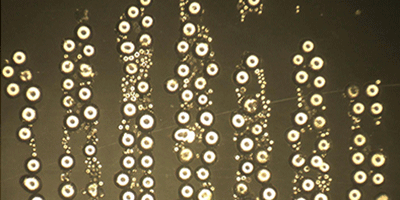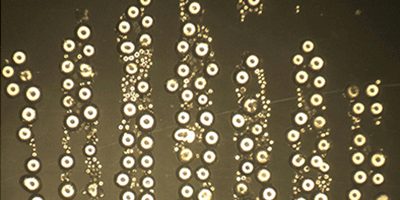Sorting by Sound
A mechanical sieve uses meshes to restrain particles above a certain size. An alternative sieving method is presented in Physical Review Applied, in which sound waves selectively trap particles based on size or density. The advantage of this so-called acoustic sieve is that the sorting can be controlled with the amplitude of the sound signal. Such a tunable sieve could help in manipulating small beads used to build up objects layer-by-layer in 3D printing.
If you place sand on top of a plate excited by sound waves, gradients in the sound-induced vibrations cause the grains to migrate to the nodes of the standing-wave pattern. Based on this idea, researchers have developed acoustic traps and tweezers that can isolate and manipulate particles. However, these systems can only handle a few particles at a time.
Hairong Zheng of the SIAT Chinese Academy of Sciences in Shenzhen, China, and his colleagues have developed an acoustic device that simultaneously traps many particles. The device, which works underwater, consists of a flat brass plate ( microns thick) with an array of etched-out rectangular strips on its top surface. An ultrasonic transducer emits sound waves that travel through the water and strike the plate from above. In previous work, the team showed that—for certain frequencies—the acoustic radiation transmits through the plate to produce rows of linear particle traps just beneath the plate. The trapping depends on the particle size and density, as well as on the strength of the ultrasonic emission. In experiments, the team lowered their sieve over a collection of different-sized glass beads. By tuning the transducer strength, they could grab up all the beads of a particular size or smaller. – Michael Schirber





